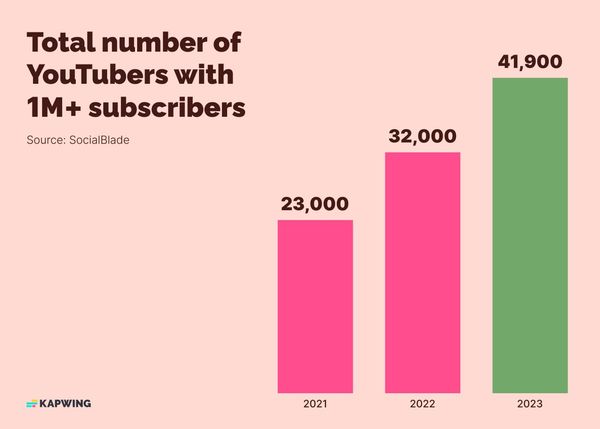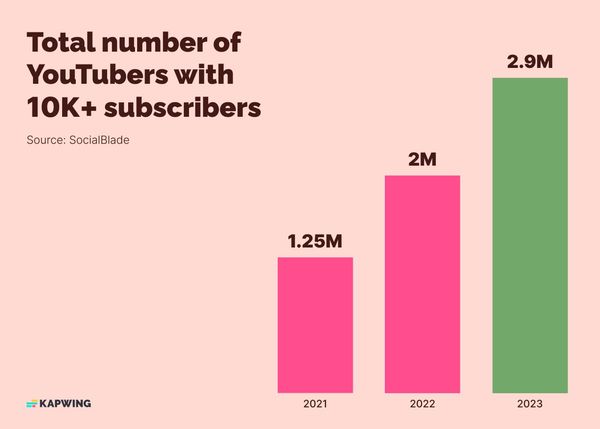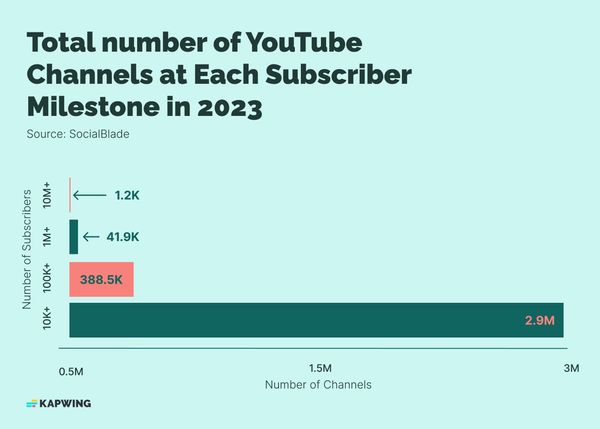Simon Owens s Media Newsletter
According to my data, it would take you roughly five years to reach your goal. Of course, you could theoretically speed up this process by posting videos at a greater frequency, but then you risk sacrificing quality, which may hinder your growth.
How Many YouTubers Have 1M Subscribers? Data Reveals the Answer.

There are 41,900 YouTube channels with over 1 million subscribers in 2023. We can estimate this based on publicly available data.
YouTube doesn’t release many official numbers around channel size or growth across its platform. However, there is a way to roughly estimate how many YouTube channels have over 1 million subscribers, and that’s with publicly available data and a little bit of investigative work.
If we search “1M subscribers” on YouTube, we can easily find channels celebrating the milestone with a dedicated video. And they should, it’s quite an accomplishment! We can find a celebratory video published in the last week by using the filters available in the YouTube Search bar.
Once we have that, we can copy and paste the channel name over to a tool like SocialBlade, which catalogs millions of YouTube channels that have a minimum of 5 subscribers. SocialBlade will tell us where in the rankings our selected channel falls on the total list of YouTube channels in their database, and they also reveal how many channels are larger than the channel we’ve selected.
Need to edit videos? Try our YouTube video editor to quickly create and edit professional looking videos for your channel.
The last channel I selected to investigate this data had recently published their 1M subscriber celebration video only 3 days prior. SocialBlade revealed that about 41.9k channels were larger at the time, which means about ~41k channels have 1 million subscribers or more.

Note: YouTube channels above 1 million subscribers often grow rapidly, so a single popular channel can quickly become an out-of-date source of information if only 1-2 weeks go by; they may have gained tens of thousands of subscribers by then. That’s why it’s important to check a channel that just recently crossed the 1M subscriber milestone.
We’ve done this every 3 months, once per quarter, for the past few years; I just set a simple calendar reminder and grab the latest number of channels with over 1M subscribers. Like most YouTube statistics, this number is a bit of a moving target. The platform is always growing. Keeping tabs on this number over time is how we’ve been able to collect a range of this data. I was honestly surprised how many channels have over 1M subscribers—congrats to those who have grown to this significant number.
But, that’s not all! There are lots of other questions we can answer with publicly available data like the above. Let’s explore even more.
How many YouTubers have 100k subscribers?

In 2023, around 388,500 YouTubers have over 100k subscribers, which is 21% more channels than in 2022.
What’s special about this milestone is that most CPM data shows that that 100k subscribers is enough to make a full-time living for many YouTubers. However, it does depend on the topics that the channel covers – some video topics are more advertiser friendly and command higher CPMs, or payouts per advertisement.
How many YouTubers have 10k subscribers?

In 2023, around 2,900,000 YouTubers have over 10k subscribers, nearly 6x more channels than those who’ve crossed the 100k milestone.
How many YouTubers have crossed each subscriber milestone?

| Number of subscribers | Total number of YouTubers |
|---|---|
| 10M | 1,200 |
| 1M | 41,900 |
| 100k | 388,500 |
| 10k | 2,900,000 |
Which YouTubers have the most subscribers?
The largest YouTubers grow much faster than your average YouTube channel. From the data we’ve seen, top channels can add millions of subscribers per week. So, who’s at the top of the list right now?
- MrBeast (137 million subscribers)
- PewDiePie (111 million subscribers)
- Like Nastya (105 million subscribers)
- Vlad and Niki (94.9 million subscribers)
- BangtanTV (73.9 million subscribers)
- Justin Bieber (71.1 million subscribers)
- Dude Perfect (59 million subscribers)
- Marshmello (56.2 million subscribers)
- Eminem (55.6 million subscribers)
- Ed Sheeran (53 million subscribers)
Read next

How to Repurpose YouTube Videos for Instagram
This week, I attended Social Media Marketing World, a big gathering of social media marketers to network and learn about best practices. I wasn’t surprised to see that video creation and editing was a HUGE theme at the conference. The opening keynote was dedicated to the importance of video

How to Add a Blurry Background to a Video
Many YouTubers and Instagram stars publish content with a blurred background behind their vertical videos, a popular technique when reposting on social media.

How to Add Bilingual Subtitles to Video
Although some social platforms and web browsers provide translations of text, they do not translate videos. In this article, I’m going to show you how to add bilingual subtitles to your videos using Kapwing.
Create content faster with Kapwing’s online video editor
Edit videos online, collaborate with your team, and reformat your content to fit every platform with Kapwing’s creative studio. Get started now for free.
Simon Owens’s Media Newsletter


A newsletter about how publishers create, distribute, and monetize their digital content. This newsletter is free to subscribe to.
How many videos does it take to get to 1 million YouTube subscribers?
The secret to overnight success is that there are no overnight successes.

How many videos does it take to get to 1 million YouTube subscribers?

Welcome! I’m Simon Owens and this is my media newsletter. You can subscribe by clicking on this handy little button:
Last week, the writer Josh Spector published a tweet that I think a lot of content creators should print out and tape above their desks: “It’s so much harder to build an audience than most people realize,” he wrote. “You’re not failing — you’re doing the work. Be patient.”
Spector was speaking to this nagging feeling many creators have at the back of their minds that they’re not growing quickly enough. We compare ourselves to really successful creators and worry that the gulf between us and them is too wide.
But it only seems that way because we often become aware of a creator’s success after they’ve already hit it big. We weren’t there to observe them grinding it out, day after day. We didn’t see them produce content that barely anyone consumed.
In fact, if you listen to any interview in which a successful creative talks about their career, you’ll often discover that they toiled away in obscurity for far longer than you realized. Before that A-list comedian landed their Netflix special, they bombed their way through hundreds of open mic nights in front of tiny audiences. That Marvel action star went on thousands of auditions and failed to land even small roles on long-forgotten TV pilots and commercials.
I interview a lot of successful creators on my own podcast and newsletter, and I almost always ask them how long it took them before they started generating a full-time income from their content. In most cases, it took them well over a year, if not much longer. In the rare cases that it took them less time, it was because they spent years creating content as part of their day job; for instance, a journalist who spent 10+ years writing for The New York Times is going to carry over a sizable audience to their just-launched Substack.
But while it’s always great to hear anecdotes about how successful media personalities put in the work before striking gold, I wanted to find a way to quantify the amount of content a creator would need to produce before they could reasonably expect to generate a full time income. Was there some data set available that would make this possible?
Sort of. There is one platform that publishes enough public audience data to allow one to track a creator’s growth: YouTube.
Not only does YouTube make subscriber counts public, but it also publicizes individual video view counts and the total number of views for a channel. What’s more, it’s very common for YouTubers to upload a video that celebrates when they hit 1 million subscribers.
The 1 million subscriber benchmark is generally used to denote that a YouTuber has “made it.” At that point, one could reasonably assume that they’re generating enough income to at least support themselves, if not a small team.
So I went about designing a way to measure the amount of work a YouTuber puts into growing their channel to a million subscribers. Let me outline my methodology and then jump into the results.
Methodology
So my methodology was pretty simple and definitely not rigorous. I doubt it would get me published in any peer reviewed journals.
I started by typing “1 million subscribers” into the YouTube search bar and then filtered the search for videos published within the last month. This resulted in a list of YouTubers who had only recently crossed the 1 million threshold.
I then began opening each channel and then counting the number of videos published prior to the video that celebrates the 1 million subscribers. I also noted the length of time the channel’s been around and the total number of views the channel received.
I repeated this process for 10 channels and recorded all the data in the spreadsheet. I then averaged all the numbers together.
Before we jump into the results, let me talk about some weaknesses in my approach.
First, 10 channels isn’t a super representative sample. There are thousands of channels that have hit at least 1 million subscribers, and with only 10, a single outlier could throw the average off by a good bit. If I wanted to be super rigorous, I would have repeated this experiment every month for at least a year.
Second, I had no way of telling whether a channel had deleted any videos. For instance, if a channel had published 400 videos before hitting 1 million subscribers but at some point deleted 50 of them, there would be no way for me to account for those deletions.
And then third, we’re definitely dealing with a certain level of confirmation bias by only focusing on channels that hit 1 million subscribers. There are of course millions of channels out there that haven’t hit 1 million, and most of them never will.
In other words, just because you go to the same number of auditions as Bradley Cooper doesn’t mean you’ll achieve the success of Bradley Cooper. There’s obviously a certain X-factor that goes into becoming a massive success and it can’t be only quantified by the amount of work that goes into it.
Ok, now that I’ve issued those caveats, let’s jump into my results.
Results
The results of my experiment were pretty much in line with what I expected.
It took an average 492 videos for a creator to hit 1 million subscribers. The lowest number in my dataset was 123 and the highest was 1,688.
It took roughly four years for the average creator to hit 1 million subscribers. Two did so in only a year and one creator took nine years to reach that number.
The average channel had 118 million total views . This meant that, on average, a channel gained a new subscriber for every 118 views its videos received. View counts for the channels in my spreadsheet ranged from 55,368,794 to 173,321,643.
What this means for you
So let’s say you’re a video creator who has the magic X-factor, meaning you’re reasonably talented and operating in a niche that isn’t oversaturated. And let’s also say you commit yourself to producing two high quality videos per week, or roughly 100 per year. How long will it take you to hit 1 million subscribers, or at least generate a full-time living on YouTube?
According to my data, it would take you roughly five years to reach your goal. Of course, you could theoretically speed up this process by posting videos at a greater frequency, but then you risk sacrificing quality, which may hinder your growth.
Looking at these numbers, it’s clear why most indie creators fail to achieve full-time status. It’s rare that someone will actually grind it out for five straight years, especially when most of that time will be spent broadcasting to a tiny audience. I remember interviewing a successful YouTuber once who told me it took him much longer to grow from 100 subscribers to 1,000 subscribers than it took him to grow from 100,000 to 500,000.
And while yes, this particular experiment focused on YouTube, the same principles apply to most other mediums, whether it’s newsletters or podcasts. You simply have to produce hundreds of pieces of longform content before hitting maximum velocity.
Part of it is about achieving momentum, but you also learn a lot between when you create your first piece of content and your 500th. You learn what kind of content resonates with your audience, but you also get better at marketing yourself. The first newsletter I sent out back in 2014 looks entirely different than it does now, and my first podcast episode sounds much worse than my most recent.
So the next time you publish a piece of content that completely flops, don’t despair. The secret to overnight success is that there are no overnight successes. Every creator you now look up to was once just like you: grinding it out, one piece of content at a time.
Do you like this newsletter?
Then you should subscribe here:
Simon Owens is a tech and media journalist living in Washington, DC. Follow him on Twitter , Facebook , or LinkedIn . Email him at [email protected]. For a full bio, go here .
]]>